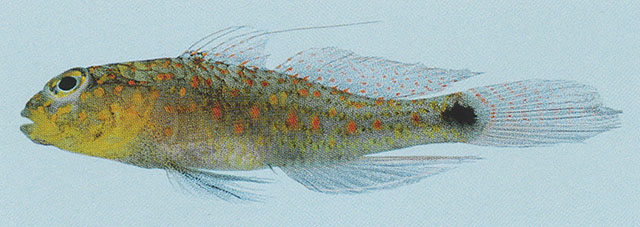| Gobiidae (Gobies), subfamily: Gobiinae |
| 2.72 cm SL (male/unsexed) |
|
demersal; marine; depth range 15 - 40 m |
| Western Pacific: Sulawesi (Indonesia) and Ponape (Caroline Islands), including Japanese waters; probably more widely distributed in the area and the Indian Ocean. |
|
Dorsal spines (total): 7-7; Dorsal soft rays (total): 9-10; Anal spines: 1-1; Anal soft rays: 8-9. This species differs from the other species of the spinosa complex in having the following set of characters: cheek spines 3-6; largest cheek spine slender obviously longer than other spines, length 2.6-6.3% SL; a pupil- or eyesized ovoid black spot on base of caudal fin (extending anteriorly to third mid-lateral scale before posterior margin of hypural); head, body and dorsal fins when alive or fresh has numerous orange speckles; first dorsal fin with no distinct black spot (Ref. 75136); characterized further by having prolonged fourth dorsal spine, forms long filament in adult; longitudinal scale series 22-24; ctenoid predorsal and body scales; cycloid scales in cheek, opercle, pectoral-fin base and prepelvic area; rounded caudal fin; depth of body 3.2-3.7 in SL (Ref. 90102). |
| Occurs in coral-reef slopes in the protected bays, found solitary on muddy or sandy-mud bottoms with dead-coral rubbles under the heavy growth of corals (Ref. 75136). |
|
Not Evaluated (N.E.) Ref. (130435)
|
| harmless |
Source and more info: www.fishbase.org. For personal, classroom, and other internal use only. Not for publication.
